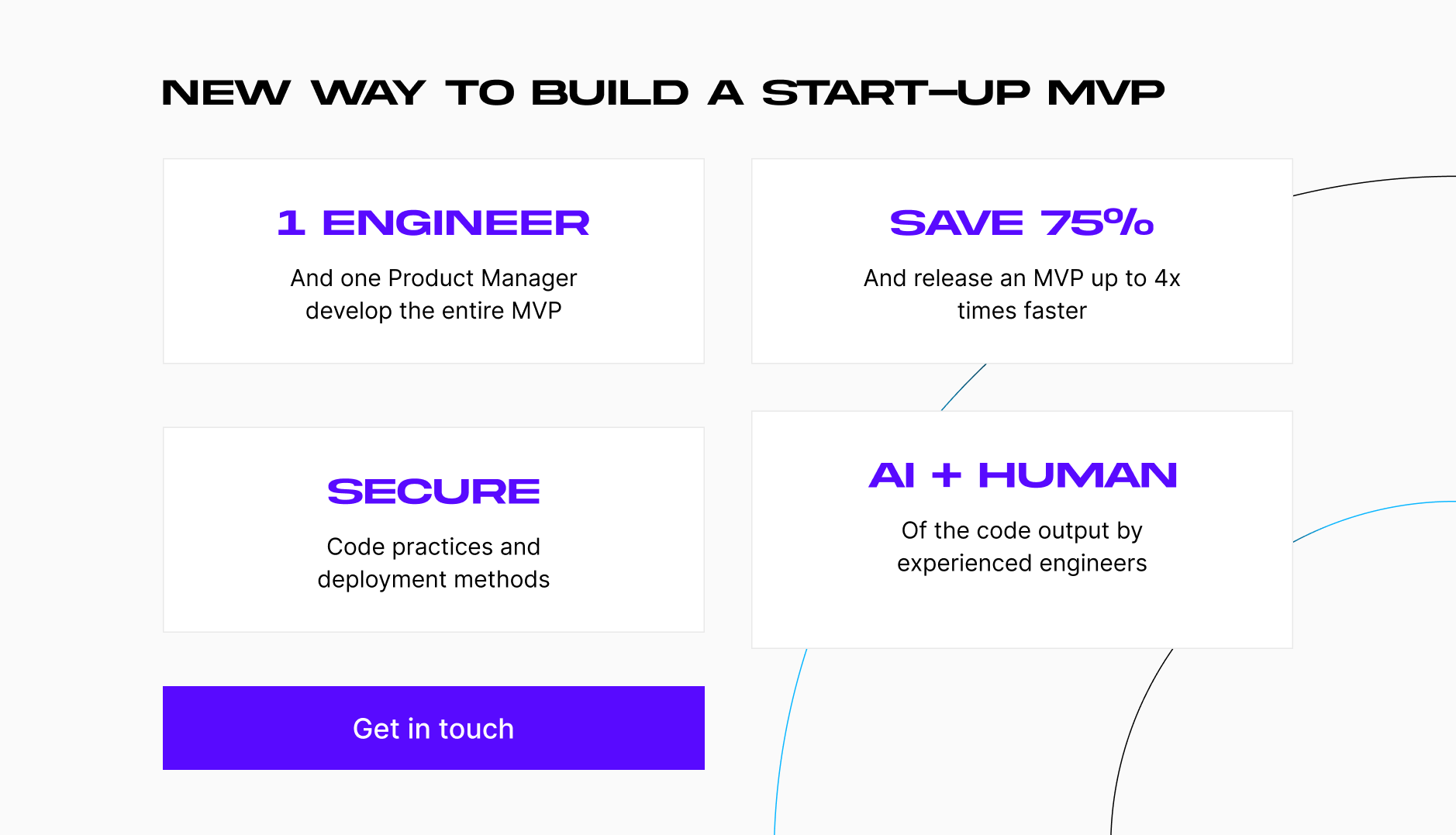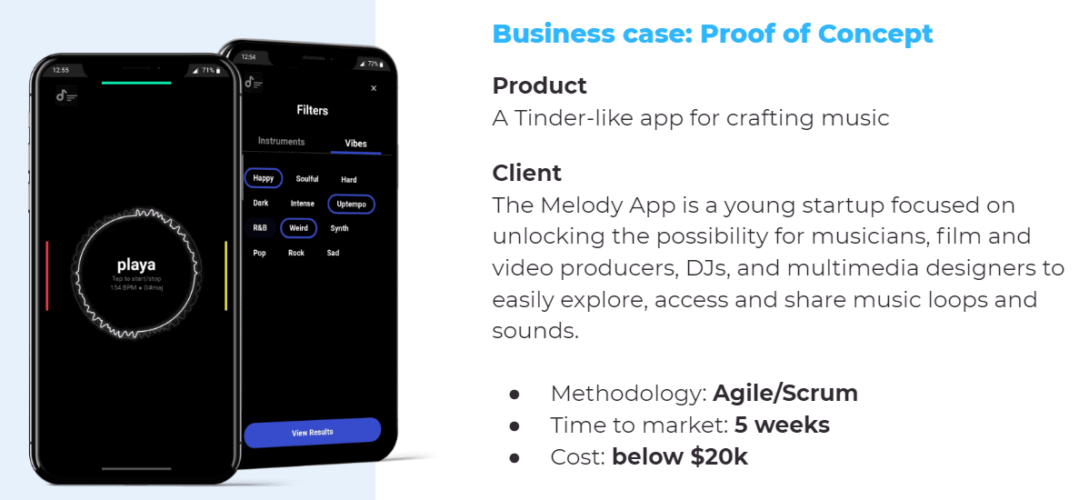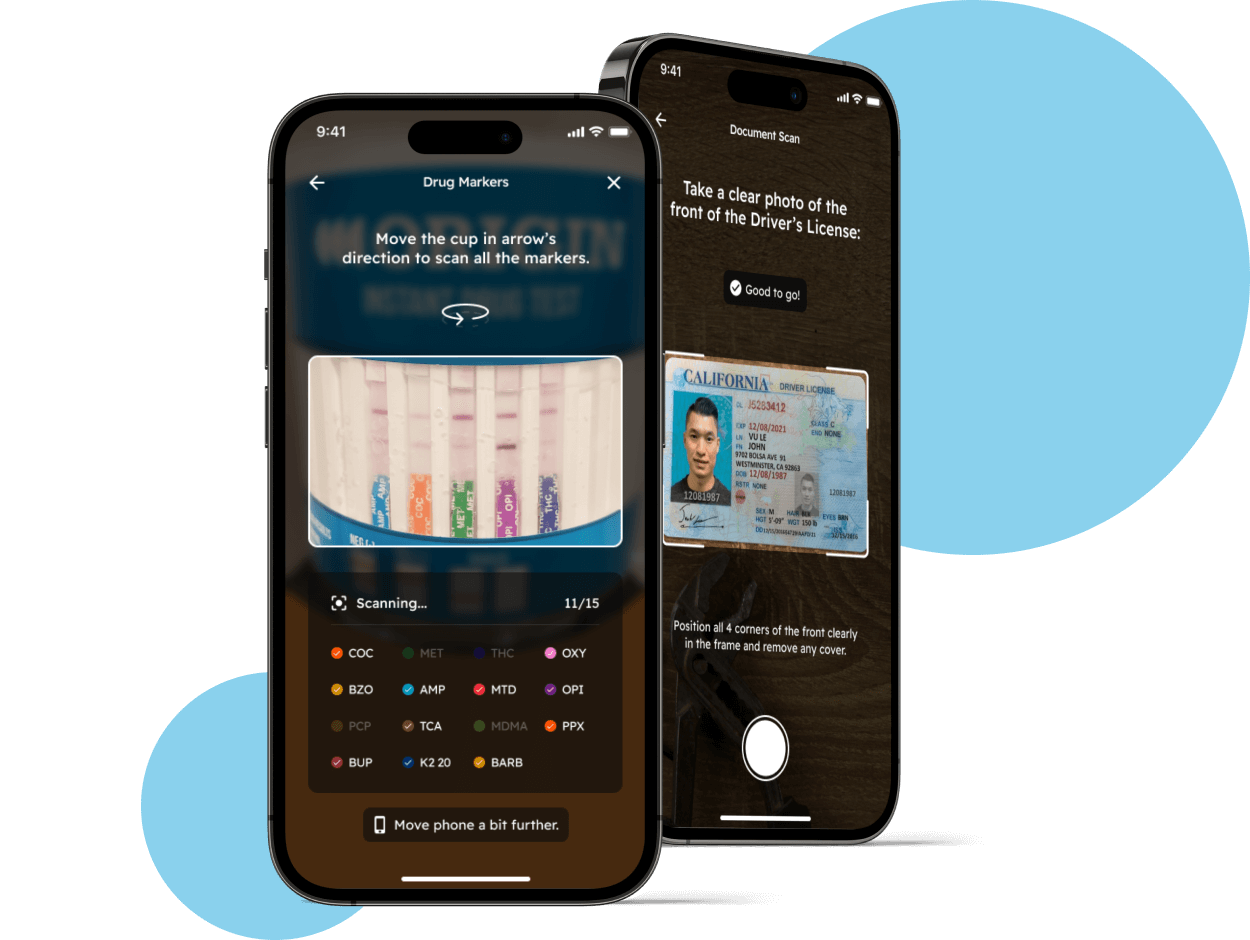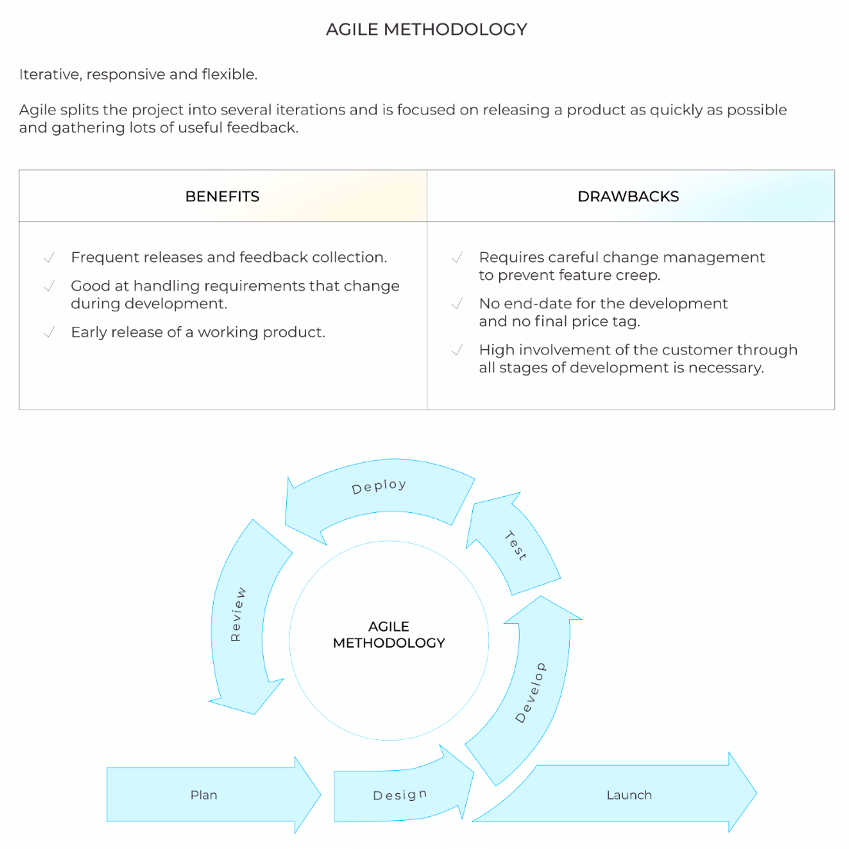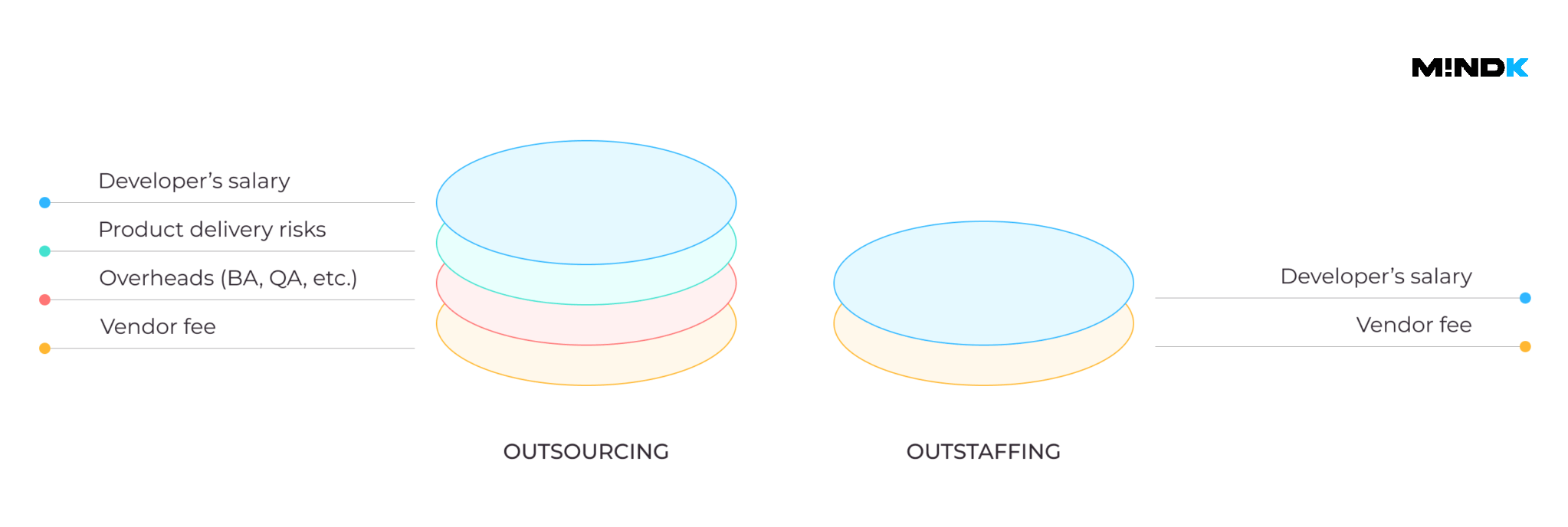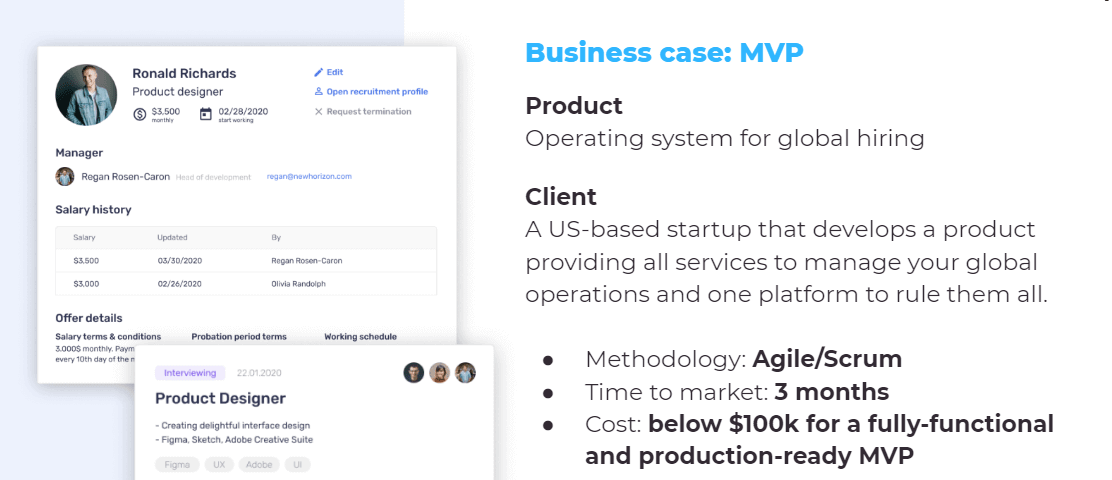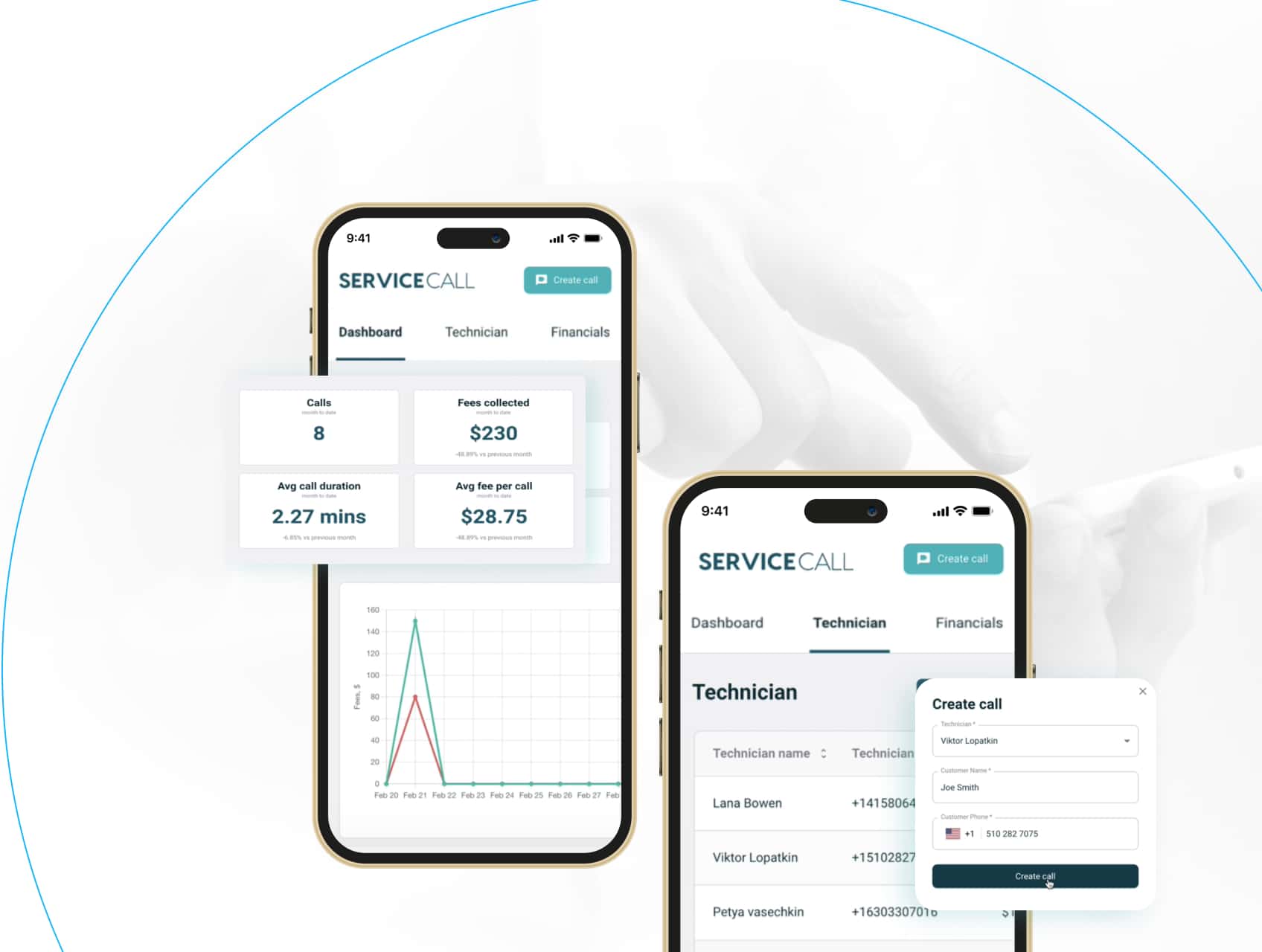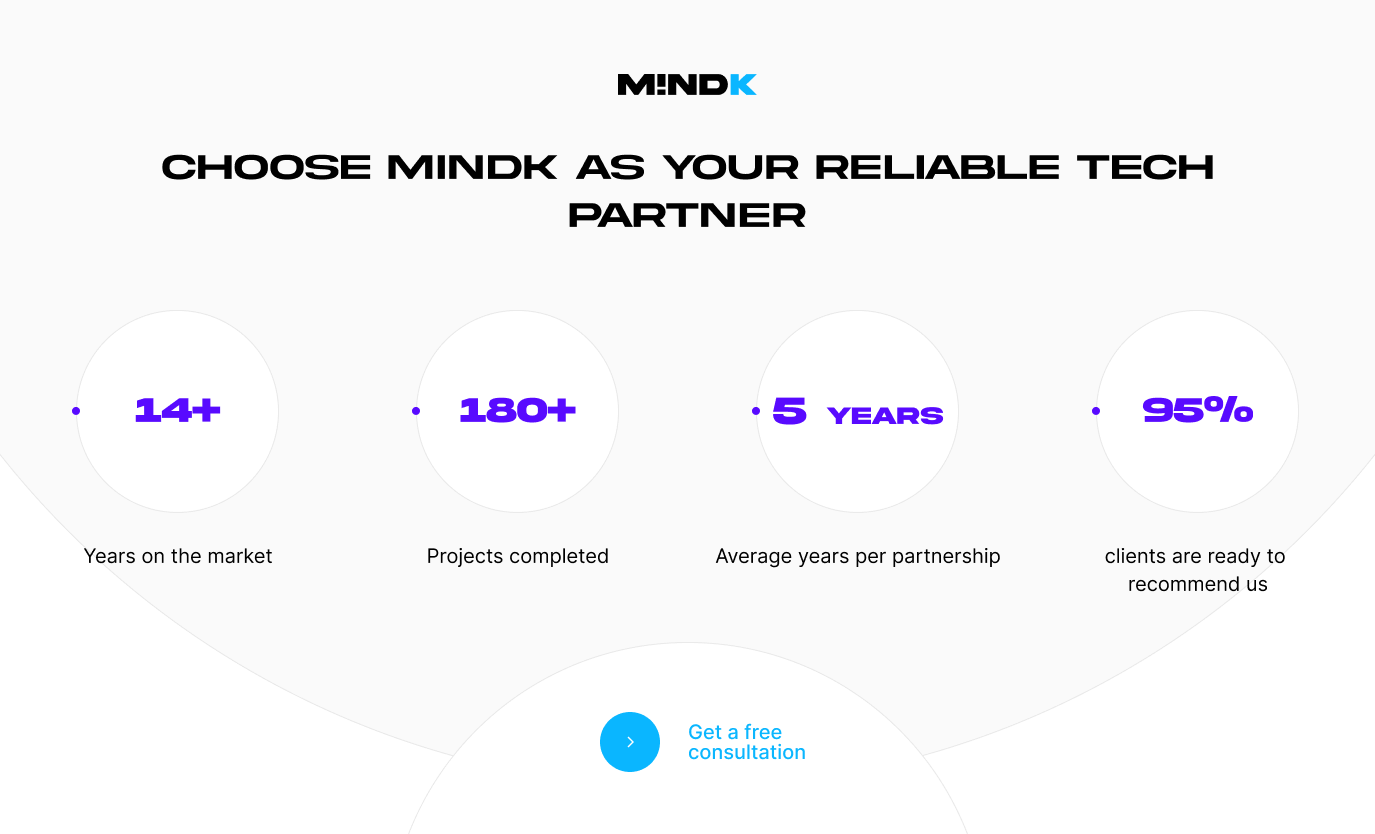Web app development costs are often confusing. Imagine asking a construction company to build a one-of-a-kind mansion in San Francisco. Most would agree that the final price will depend on many factors, such as the house size, number of rooms, total floor area, exterior and interior finish, architectural plans, permissions, and so on.
The same applies to software development. For example, a web app that requires API integrations, data analytics, or other complex features will cost you more than a standalone app. Similarly, there’s also a big difference between engaging a group of freelancers or a web app development company like MindK.
To help you determine web app costs, we’ll explore the key factors influencing the budget, the top cost-cutting strategies, as well as the cost ranges for popular types of software.
Factors that influence web app development cost
Let’s take a look at the components that determine the answer to the question of how much it costs to develop a web application:
- The scope of work.
- Business niche.
- UI/UX design.
- Deadlines.
- Non-functional requirements.
- Development company.
- Technical complexity of features.
- Engagement model.
Scope of work is a set of features the application must have or the work required to develop them. The larger the scope, the higher the costs.
A narrow business niche makes it difficult to find specialists who know their onions. So expect higher costs.
Technical complexity of features is another factor. Some features have plenty of libraries and ready-made solutions, like MindK’s Product Development Framework (PDF), which saves about 20% of the project costs. One-of-a-kind functionality, on the other hand, requires further research and development. So innovative solutions are more expensive and hard to estimate.
Custom UI/UX design is more expensive than pre-built templates and themes, as it’s tailored to fit custom branding.
Tight deadlines require more dedicated resources. Higher risks increase the need for effective management. Moreover, simply adding more developers to the team comes with diminishing returns, as it’s hard to divide complex tasks into smaller, more manageable subtasks.
Non-functional requirements are various characteristics that describe how the application works. If your solution has millions of users, it should be extra reliable, secure, fast, and have almost no downtime. Developing high-load systems requires a specific architecture and more effort than regular applications. Compliance with regulations like HIPAA is another costly requirement.
Web developer costs comparison
The cost of development with the same requirements, functionality, and engagement model still varies based on:
- Technology partner (company size, reputation, specialization).
- Their level of experience.
- Geographical location.
Due to brand recognition, the services of well-known companies usually cost a lot. At the same time, vendors with experience in specific industries may charge more for their knowledge of business processes, regulations, technologies, and user needs.
But how do developer rates compare across different locations?
Software Engineer total annual compensation [2025]
Country | All levels | Senior |
| USA | $177,250 | $225,000 |
|---|---|---|
| UK | $107,081 | $142,495 |
| Canada | $96,635 | $118,068 |
| Australia | $96,345 | $120,000 |
| Netherlands | $90,727 | $104,354 |
| Singapore | $90,000 | $120,040 |
| Germany | $87,000 | $96,946 |
| China | $75,000 | $113,017 |
| France | $62,730 | $84,504 |
| Spain | $62,277 | $74,959 |
| Poland | $62,350 | $78,000 |
| Czech Republic | $60,000 | $71,900 |
| Ukraine | $55,000 | $66,000 |
| Brazil | $37,345 | $52,455 |
| India | $30,283 | $54,192 |
According to the levels.fyi
The shortage of developers during the pandemic has significantly increased salaries almost everywhere.
In 2024, this growth in developer rates slowed to a crawl. Most vendors now plan modest single-digit increases in 2024 to cover inflation, which is especially high in places like Latin America and South Asia.
So, outsourcing web development to a company like MindK could easily save you $7,000+ a month per Senior developer.
Average web development cost
To help you understand the rough costs immediately, we’ll now provide web application development cost estimation by complexity. These are the average cost ranges from companies like MindK. A precise estimation will, of course, depend on your features and the developer rates.
Basic (simple) web apps
Traditional cost range: $20,000 – $50,000
AI-driven development: $2,000 – $5,000
Basic projects usually involve simple functionality, minimum content and interactive elements, plain UI/UX, and simple search functions.
- Simple web apps with predefined template layouts.
- Small online catalogs.
- Promo websites.
- Widgets or additional features in existing web apps.
We often recommend using low-code and no-code platforms like bubble.io to accelerate time-to-market, reduce costs, and risks. Generative AI is another tool in the box. Our experience with the MindK AI-driven development framework shows that AI can save up to 90% of your budget, depending on the project complexity.
However, both AI and no-code platforms limit your ability to upgrade the product with new features. Producing AI-generated code that’s easy to maintain requires much more time and effort than creating a simple proof of concept.
Startup web apps (Proof of Concept, or PoC)
Traditional cost range: $50,000 – $70,000
AI-driven development: $10,000 – $18,000
These web applications often help founders to acquire funding for developing a fully-fledged product. They are more interactive and contain a lot of content, media, and functionalities.
Such apps typically take under 1,000 hours of development time.
MindK once ran a competition for the best app idea The winning concept was a music creation app from a team of Grammy-award winning producers. Instead of building three native apps for iOS, Android, and the web, we suggested developing a single Progressive Web Application (PWA) to run on all platforms.
After five weeks of development, the team validated the solution and raised the funds to launch the startup.
Mid-complexity web apps and innovative MVP
Traditional cost range: $100,000 – $250,000
AI-driven development: $25,000 – $180,000
Mid-complexity apps take up to 3,000 hours of development time.
They usually include advanced features like audio/video processing, analytics, real-time synchronization, integrations with third-party services, and so on.
One of the best ways to reduce costs and risks for such an app is to release as fast as possible. Limiting the features for a Minimum Viable Product (MVP) helps validate your ideas on the market. You’ll often get unexpected feedback from users and investors, altering the entire direction of the project.
For example, a US healthcare company wanted to speed up mandatory drug screening. MindK developed an AI algorithm that instantly recognizes the test results. To cut costs, the admin panel used cloud-native services and PWA tech.
After releasing the 1.0 version, everybody was surprised to find partners interested in using the admin panel. The team collected feedback, prioritized findings, and started building a much more comprehensive SaaS product.
Explore our healthcare case studies
Complex & enterprise web apps
Traditional cost range: $300,000+
AI-driven development: $250,000+
Such applications often target various B2B SaaS niches, automate enterprise processes, or build upon a successful MVP. They require 6-24 months of development time with a cross-functional team.
Let’s take, for example, the drug screening app I’ve described above. With the second version, the client wanted to digitize hundreds of services they provide. To satisfy partners, they also had to re-architect the app into a SaaS product. To offset the increased complexity, the team used a variety of cost-saving measures:
- Using existing services and libraries whenever possible.
- Services like AWS Lambda for cost-effective computing and autoscaling.
- API integrations for payment services, appointment scheduling, clinical tests, and much more.
- HIPAA automation using Terraform infrastructure as code.
These efforts paid off as 12 enterprises have already adopted the SaaS application.
Typical web application feature costs
| Feature | Information | Time estimate | Costs |
| Sing up/login | OAuth, user registration, password recovery, and RBAC setup using AWS Cognito or similar services. | 120 – 200 hours | $6,000 – $10,000 |
| User Management | Profile management, user groups, activity monitoring, and user invitations. | 160 – 240 hours | $8,000 – $12,000 |
| Company Management | Managing organizational structures, data access rules, custom settings, audit logs, performance metrics, and bulk operations. | 200 – 300 hours | $10,000 – $15,000 |
| Search | AWS Elasticsearch to index and search data, autocomplete, full-text search across multiple data types and tables. | 40 – 200 hours | $2,000 – $10,000 |
| Payments and Invoicing | Stripe/PayPal integration, cart, checkout functionalities, basic invoicing systems. | 150 – 250 hours | $7,500 – $10,000 |
| Notifications | Email services, SMS notifications, real-time push notifications. | 100 – 150 hours | $5,000 – $7,500 |
| Integrations | SSO, API access setup for external integrations, and data synchronization mechanisms across platforms. | 80 – 150 hours | $4,000 – $7,500 |
| Analytics and Reporting | Real-time analytics, custom reports, data visualization dashboards. | 120 – 200 hours | $6,000 – $10,000 |
| Security | Secure login, setting up comprehensive privacy controls, and ensuring compliance with data protection regulations. | 80 – 120 hours | $4,000 – $6,000 |
| Map and geolocation | User location tracking, points of interest, map search. Advanced features like heat maps, complex queries, and route plotting. | 40 – 300 hours | $2,000 – $15,000 |
Long-term maintenance costs
Releasing a web application is usually not enough to achieve lasting success. Marketing, sales, onboarding, and customer support are significant cost sinks for most companies. Founders typically get a ton of feedback and real-world data that informs future improvements.
Therefore, long-term maintenance costs include:
- 10-25% of the budget for bug fixing and performance improvements.
- 15-20% of the web development budget annually for ongoing maintenance.
- $2,000+ monthly AWS bills without cloud cost optimization.
- External API costs (depends on specific APIs).
How engagement models affect project costs
The cost of web development also highly depends on the web development services you need. For example, at MindK we provide:
- End-to-end new product development (starting from MVP);
- Custom software development;
- Team augmentation;
- IT consulting.
End-to-end product development
A client delegates the entire project to an IT provider. The vendor allocates a team of professionals, manages them, and does all the work necessary to create the product.
This strategy is better suited for companies without an in-house IT department. Another use case is delivering new products or services from scratch.
The tech partner takes on more responsibilities, including project management, design, business analysis, architecture, testing, and so on. So full-cycle development is usually more expensive than paying for a couple of developers in an augmented team.
At MindK, we use the Agile software development methodology for such projects. Agile frameworks like Scrum or Kanban thrive in mid-to-long-term projects with incomplete requirements or a high degree of uncertainty.
We highly recommend reading the Decision Maker’s Guide to Agile Product Development if you want to learn more about how to engage with an Agile project as a client.
Team augmentation
Quickly fill the required positions on your team with senior remote engineers. You retain complete control over the project. Meanwhile, the partner handles recruitment, education, training, retention, and employee productivity.
For instance, each MindK employee receives a unique career plan, coaching from experienced engineers, and team leadership assistance. We devote significant time and effort to ensuring that our professionals are at the top of their game.
Team augmentation allows you to easily scale from one engineer to a large team and visa versa. You pay for each specialist separately – with rates up to 20% cheaper than regular outsourcing.
This model suits companies with tech expertise and who are ready to bear full responsibility for managing developer workload, schedule, and budget.
Fixed price vs non-fixed price projects
Software development companies use a variety of engagement models that also affect the costs.
In fixed-price contracts, the budget, timescale, and volume of work are set in stone and stipulated by both parties beforehand. They require complete requirements and tight control over changes. Fixed-price projects usually have a lengthy discovery phase needed for precise estimation. Developers bear all the risks and can’t exceed the estimated budget and deadlines so charge more to mitigate the risks. Moreover, a fixed scope makes the project too inflexible for dynamically changing markets.
Non-fixed-price engagement models like Time & Materials or Cost Plus are much more flexible. The project scope is not set in stone, developers working on the pay-as-you-go basis. Contractors and clients share the risks so project costs are much lower. What’s more, you can better react to any market changes.
If you want a healthy compromise, you can develop an MVP under a fixed-price contract and then switch to a more flexible model.
How to reduce development costs
Several factors decrease the cost of developing a web application.
#1 Cut the scope to build an MVP
Leave only the essential parts of the app to build a Minimum Viable Product. Many successful products that we came to love over the years, like Uber and Dropbox, started as small proofs of concept. MindK has also used this approach when building over a hundred successful applications.
#2 Leverage AI, low-code, and no-code tools
The first rule of MVP development is “don’t over-engineer”. So, use existing solutions, libraries, integrations, and any tools that can speed up development.
Low-code and no-code (LCNC) platforms like Bubble.io can provide a visual development environment with drag-and-drop interface modelers, pre-built components, smart services, connection templates, and so on. They enable people with limited technical and coding abilities to create new apps.
This doesn’t mean that the LCNC platforms allow you to build a quality end product. However, they can reduce the scope of work and save developers time on more valuable features.
The same goes for AI tools like Copilot, Claude, and ChatGPT. At MindK, we recently tested the limits of AI-assisted coding on a commercial project. It included creating a mobile app to allow plumbers, electricians, and handymen earn money with remote consultations.
The budget was estimated at ~$200,000 due to a unique combination of APIs and custom logic.
The challenge was to reduce the costs by outsourcing as many tasks as possible to Generative AI. A single engineer managed to do the work of a five-person Scrum team. The total savings reached $162,800. However, the project revealed the gaps in current AI capabilities. These included difficulties in working with the database, the project’s file and folder structure, as well as complex iterative flows.
The verdict is clear – you still need human engineers to create a great product.
Saving $162,800 with AI-driven development [Case Study]
#3 Use a cloud-native approach
It’s a method for developing and running responsive, scalable, and fault-tolerant apps in public, private, or hybrid clouds. Cloud-native development emphasizes modular architecture, loose coupling, and service independence. The key characteristics of such apps are:
- Microservices divide applications into self-contained services or modules. Each service refers to its own data, serves a distinct business purpose, and communicates with other modules via APIs or messages.
- Containers ensure that microservices do not interfere with one another. They logically separate the app, allowing it to execute independently of physical resources.
- APIs link microservices and containers while simplifying maintenance and security and allowing microservices to communicate with one another.
- Dynamic orchestration manages complicated life cycles of containers. Container orchestration handles resource management, load balancing, scheduling restarts after an internal failure, provisioning, and deploying containers onto server cluster nodes.
The cloud-native approach is more cost-effective because computing and storage resources may be scaled up or down as required. Virtual servers are readily deployed for testing, and cloud-native apps may be up and running quickly. Containers may also be utilized to increase the number of microservices that can operate on a single host, saving time, resources, and money.
How to prevent risks and unexpected costs
There are two reasons why web applications may cost more than estimated.
- Scummy companies that provide a low price intentionally to catch your interest.
- Scope creep that happens during development.
Here’s how to prevent both.
Ensure your partner is transparent from the outset. At MindK, we usually start with a short introductory call to learn about your project. You can request an NDA to protect your IP before revealing any information. Within 2 days, the team prepares a rough estimate – an approximate number of hours needed to complete your project.
After signing a contract, there’s usually a 2-4 week Discovery phase to learn more about your needs. We’ll analyze your requirements, prioritize them, and prepare prototypes during this time. After the Discovery phase, you get a detailed app development cost breakdown that better reflects the amount of work needed to complete your project.
Most reputable companies have a similar process. They should also remain transparent about any problems or new risks related to the project.
Now, let’s handle the second problem.
A lot of clients come up with new ideas when the project is already under development. This scope creep is one of the top reasons why software development costs escalate beyond the initial estimate.
To control your budget, use Agile change management with a product backlog. It’s an extensive list of software development tasks, sorted by importance. Every two weeks, software engineers pull several highest-priority tasks from the backlog to complete in the next iteration.
Once a new idea appears, add it to the project backlog. Before each iteration, the team re-prioritizes the entire backlog to prevent you from wasting your time on irrelevant “wants and wishes”. This approach helps you focus on top business needs, optimize ROI, and streamline the development process.
As for other eventualities, we described how to mitigate outsourcing risks in another article.
Conclusions
Different factors and decisions affect web app development costs.
Scope of work, business niche, the technical complexity of the project’s features, design and user interface, deadlines, non-functional requirements, choice of developer, and engagement models are some of the most important ones. A great portion of the budget is going to be spent on marketing, updates and added features, maintenance, and customer support.
So, if you want to get a more precise estimate, it’s better to contact web development companies directly. Only after discussing the ins and outs of your project, can you decide where to cut corners and where to pay more for the highest quality.
So feel free to contact MindK to get a free quote and answers to your questions.

